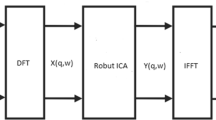Abstract
This paper presents a method for blind separation of convolutive mixtures of speech signals, based on the joint diagonalization of the time varying spectral matrices of the observation records and a novel technique to handle the problem of permutation ambiguity in the frequency domain. Simulations show that our method works well even for rather realistic mixtures in which the mixing filter has a quite long impulse response and strong echoes.
Preview
Unable to display preview. Download preview PDF.
Similar content being viewed by others
References
Anemüler, J., Kollmeier, B.: Amplitude modulation decorrelation for convolutive blind source separation. In: Proceeding of ICA 2000 Conference, Helsinki, Finland, June 2000, pp. 215–220 (2000)
Mukai, R., Araki, S., Makino, S.: Separation and dereverberation performance of frequency domain blind source separation. In: Proceeding of ICA 2001 Conference, San- Diego, USA, December 2001, pp. 230–235 (2001)
Parra, L., Spence, C.: Convolutive blind source separation of non-stationary sources. IEEE Trans. on Speech and Audio Processing 8(3), 320–327 (2000)
Pham, D.T.: Joint approximate diagonalization of positive definite matrices. SIAMJ. on Matrix Anal. and Appl. 22(4), 1136–1152 (2001)
Pham, D.T., Cardoso, J.-F.: Blind separation of instantaneous mixtures of non stationary sources. IEEE Trans. Signal Processing 49(9), 1837–1848 (2001)
Pham, D.T., Servière, C., Boumaraf, H.: Blind separation of convolutive audio mixtures using nonstationarity. In: Proceeding of ICA 2003 Conference, Nara, Japan (April 2003)
Pham, D.T., Servière, C., Boumaraf, H.: Blind separation of speech mixtures based on nonstationarity. In: Proceeding of the ISSPA 2003 Conference, Paris, France (July 2003)
Smaragdis, P.: Blind separation of convolved mixtures in the frequency domain. In: International Workshop on Independence & Artificial Neural Networks, University of La Laguna, Tenerife, Spain (February 1998)
Wu, H.-C., Principe, J.C.: Simultaneous diagonalization in the frequency domain (SDIF) for source separation. In: Proceeding of ICA 1999 Conference, Aussois, France, January 1999, pp. 245–250 (1999)
Author information
Authors and Affiliations
Editor information
Editors and Affiliations
Rights and permissions
Copyright information
© 2004 Springer-Verlag Berlin Heidelberg
About this paper
Cite this paper
Serviere, C., Pham, DT. (2004). A Novel Method for Permutation Correction in Frequency-Domain in Blind Separation of Speech Mixtures. In: Puntonet, C.G., Prieto, A. (eds) Independent Component Analysis and Blind Signal Separation. ICA 2004. Lecture Notes in Computer Science, vol 3195. Springer, Berlin, Heidelberg. https://doi.org/10.1007/978-3-540-30110-3_102
Download citation
DOI: https://doi.org/10.1007/978-3-540-30110-3_102
Published:
Publisher Name: Springer, Berlin, Heidelberg
Print ISBN: 978-3-540-23056-4
Online ISBN: 978-3-540-30110-3
eBook Packages: Springer Book Archive




